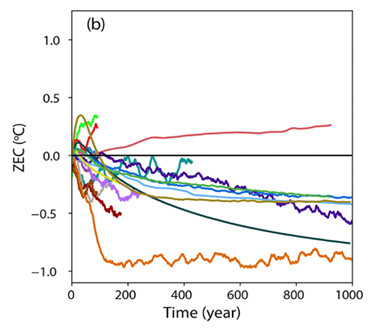Last week, the Climate Council, the wise council appointed by Rob Jetten that is supposed to guide Dutch climate policy, made its voice heard again. Under the pseudonym Clear the air? (Don’t we have enough official reports with nonsense titles yet?) They have issued advice on removing carbon dioxide from the air, or negative emissions.
We already have a pile of reports from all sorts of committees about reducing Emissions Of CO2 (and other greenhouse gases, but you can convert them to CO2 equivalent). However, on top of that, according to the Climate Council, we also need to achieve negative emissions. In their view, these negative emissions are necessary because we want to achieve net-zero CO2 emissions by 2050.
CCS and bioCCS
After all, some sectors of society, such as agriculture and aviation, are simply not possible to be net-zero in that period. Cows continue to emit powerful methane, for example, and electric aviation is not possible. To achieve net zero, these sectors’ annual emissions would have to be offset by removing an equivalent amount of carbon dioxide from the air each year.
The report mentions a number of technologies for doing this, but the only real technology is actually carbon capture and storage (CCS). CCS is already happening on a fairly large scale, and the Porthos project is working on it in the Netherlands. With CCS, CO2 from fossil fuels (e.g. in coal or gas-fired power plants) is captured and stored underground forever in empty oil and gas fields. CCS (carbon capture and storage) largely prevents CO2 emissions at the facilities where it is implemented.
BioCCS means that you burn biomass (mainly wood from trees) in a power plant or heating network boiler and capture the carbon dioxide and store it underground. Since those trees once absorbed the same amount of carbon dioxide from the air as they grew, bioCCS removes carbon dioxide from the atmosphere permanently indirectly. The Climate Council estimates the potential for bioCCS in the Netherlands at around 22 million tonnes of carbon dioxide per year.
The problem, as is well known, is that you need huge areas of forest to produce all this wood. That is not possible in the Netherlands anyway, so the wood has to be imported. It is no surprise then that the picture of the heavily subsidized co-firing of millions of tons of wood pellets from the US and Latvia in coal-fired power plants is now very bad. This CO2 is not currently being captured, but even if it were to happen from now on, the objection remains that large-scale CO2 capture and storage would come at the expense of forests and perhaps even farmland elsewhere in the world.
climate change guilt
Aside from the costs of imports and necessary subsidies – which the Climate Council, as usual, says nothing about – it makes no sense for the Netherlands to shift its climate guilt to other countries by pulling up forests all over the world here, burning them here and putting the CO2 underground here.
For countries with low population density and large forests, such as Sweden and Finland, CCS may be an option for achieving radical net emissions reductions – perhaps to zero or even negative – but not for a small, densely populated, heavily industrialized country like the Netherlands.
Net zero is not necessary.
Net zero isn’t necessary. Why not? Which brings us back to the last reference. Winya week Discussion on the need for net zero by 2050, which is essential to stop global warming.
Both physicist Jack Hagoort and the undersigned in the book climate optimistSome researchers argue that even if CO2 emissions are reduced significantly, but not reduced to zero, global warming will stop this century and gradually cool. The reason is that the oceans and the biosphere (forests and soils) will continue to absorb large amounts of CO2 for a long time, even if we succeed in reducing our emissions significantly, which would reduce the concentration of CO2 in the atmosphere.
Guido van der Werf, a climate scientist and advisor to the Climate Council, described this as “misinformation” in a Guest Blog on Climate balconyThere will still be so much warming in the Earth and climate system’s pipeline that even a 100% reduction in emissions by 2050 would provide sufficient relief. Details of that discussion can be read here.
Typical Accounts
The amount of global warming that would occur if we stopped emitting carbon dioxide is actually very uncertain. In climate science, this is called Zero Emissions CommitmentZEC. This refers to the number of degrees the climate would continue to warm if we stopped all carbon dioxide emissions immediately. Of course, ZEC cannot be measured experimentally, so we derive it from model calculations. This happened most recently in 2020 with 18 advanced climate models.
The situation is, as usual in climate science, that these models all give a different result, ranging from +0.29 to -0.36 degrees. So, depending on which model you want to believe, there’s a maximum of 0.29 degrees of warming in the pipeline, or 0.36 degrees of cooling.
The average of all the models suggests a slightly negative ZEC, -0.12 degrees. So net zero emissions would not only stop global warming; the world would also slowly start to cool.
The incompetence of climate science does not in itself constitute the continued great uncertainty about the amount of expected temperature increase. Climate is simply a very complex thing.

But the 0.65-degree bandwidth is very large: it is larger than the difference between 1.5 degrees of global warming (the original goal of the Paris climate agreement) and 2.0 degrees, the upper limit of “dangerous global warming” that the agreement itself must never exceed.
So even if we reach net zero much later than 2050, one climate model says that limiting warming to 1.5 degrees will be easily achieved, while another equivalent climate model says that we will pass the danger zone for warming above 2 degrees Celsius.
The claim, like Van der Werf and the Climate Council, that net zero only in 2050 is a science-based policy is unjustifiable. It is a political choice, and they should acknowledge it publicly. After all, net zero in 2050, with its associated CO2 budget calculated to be in the order of gigatonnes, is based on a ZEC of 0.00 degrees. If the ZEC model value is -0.12 degrees, net zero is not necessary to stop global warming, and the concept of a “CO2 budget” loses its meaning. Because then a limited level of CO2 emissions would still be permissible for many years to come.
Leave the last 20 percent alone.
Both Hagurt and I go there. de facto Assuming ZEC is slightly negative. Hagworth is more radical on this than I am. climate optimist: It should be noted that a 35 percent reduction in emissions is enough to stay below 2 degrees of warming. Given international developments, I am assuming a practical reduction of about 80 percent in CO2 emissions. This is within the bandwidth of those 18 climate models, all of which say something different from ZEC.
That’s why we can simply leave the last 20% of ongoing emissions in place, and CCS is not necessary.
From the science journalist Arnot Jaspers emerged climate optimistAbout the energy transition in the Netherlands. The book is here To request. Information for media and libraries: info@blauwburgwal.nl
Winya week On your doorstep every Wednesday and Saturday morning. Donors make it possible. Will you be a donor too? Which can here. Thank you!

“Total coffee specialist. Hardcore reader. Incurable music scholar. Web guru. Freelance troublemaker. Problem solver. Travel trailblazer.”







More Stories
GALA lacks a chapter on e-health
Weird beer can taste really good.
Planets contain much more water than previously thought